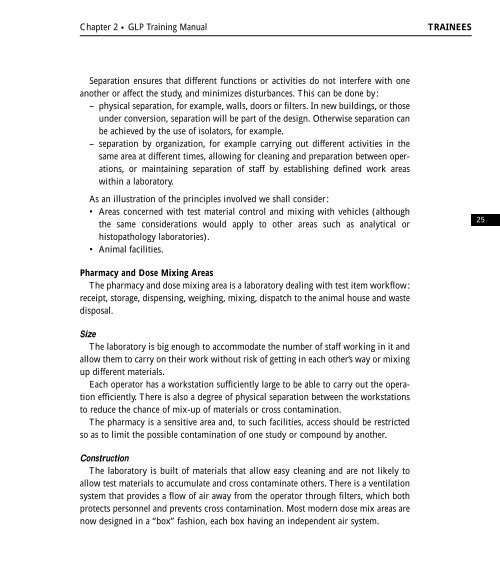TRAINEE - World Health Organization
TRAINEE - World Health Organization
TRAINEE - World Health Organization
Create successful ePaper yourself
Turn your PDF publications into a flip-book with our unique Google optimized e-Paper software.
Chapter 2 • GLP Training Manual <strong>TRAINEE</strong>S<br />
Separation ensures that different functions or activities do not interfere with one<br />
another or affect the study, and minimizes disturbances. This can be done by:<br />
– physical separation, for example, walls, doors or filters. In new buildings, or those<br />
under conversion, separation will be part of the design. Otherwise separation can<br />
be achieved by the use of isolators, for example.<br />
– separation by organization, for example carrying out different activities in the<br />
same area at different times, allowing for cleaning and preparation between operations,<br />
or maintaining separation of staff by establishing defined work areas<br />
within a laboratory.<br />
As an illustration of the principles involved we shall consider:<br />
• Areas concerned with test material control and mixing with vehicles (although<br />
the same considerations would apply to other areas such as analytical or<br />
histopathology laboratories).<br />
• Animal facilities.<br />
Pharmacy and Dose Mixing Areas<br />
The pharmacy and dose mixing area is a laboratory dealing with test item workflow:<br />
receipt, storage, dispensing, weighing, mixing, dispatch to the animal house and waste<br />
disposal.<br />
Size<br />
The laboratory is big enough to accommodate the number of staff working in it and<br />
allow them to carry on their work without risk of getting in each other’s way or mixing<br />
up different materials.<br />
Each operator has a workstation sufficiently large to be able to carry out the operation<br />
efficiently. There is also a degree of physical separation between the workstations<br />
to reduce the chance of mix-up of materials or cross contamination.<br />
The pharmacy is a sensitive area and, to such facilities, access should be restricted<br />
so as to limit the possible contamination of one study or compound by another.<br />
Construction<br />
The laboratory is built of materials that allow easy cleaning and are not likely to<br />
allow test materials to accumulate and cross contaminate others. There is a ventilation<br />
system that provides a flow of air away from the operator through filters, which both<br />
protects personnel and prevents cross contamination. Most modern dose mix areas are<br />
now designed in a “box” fashion, each box having an independent air system.<br />
25

















